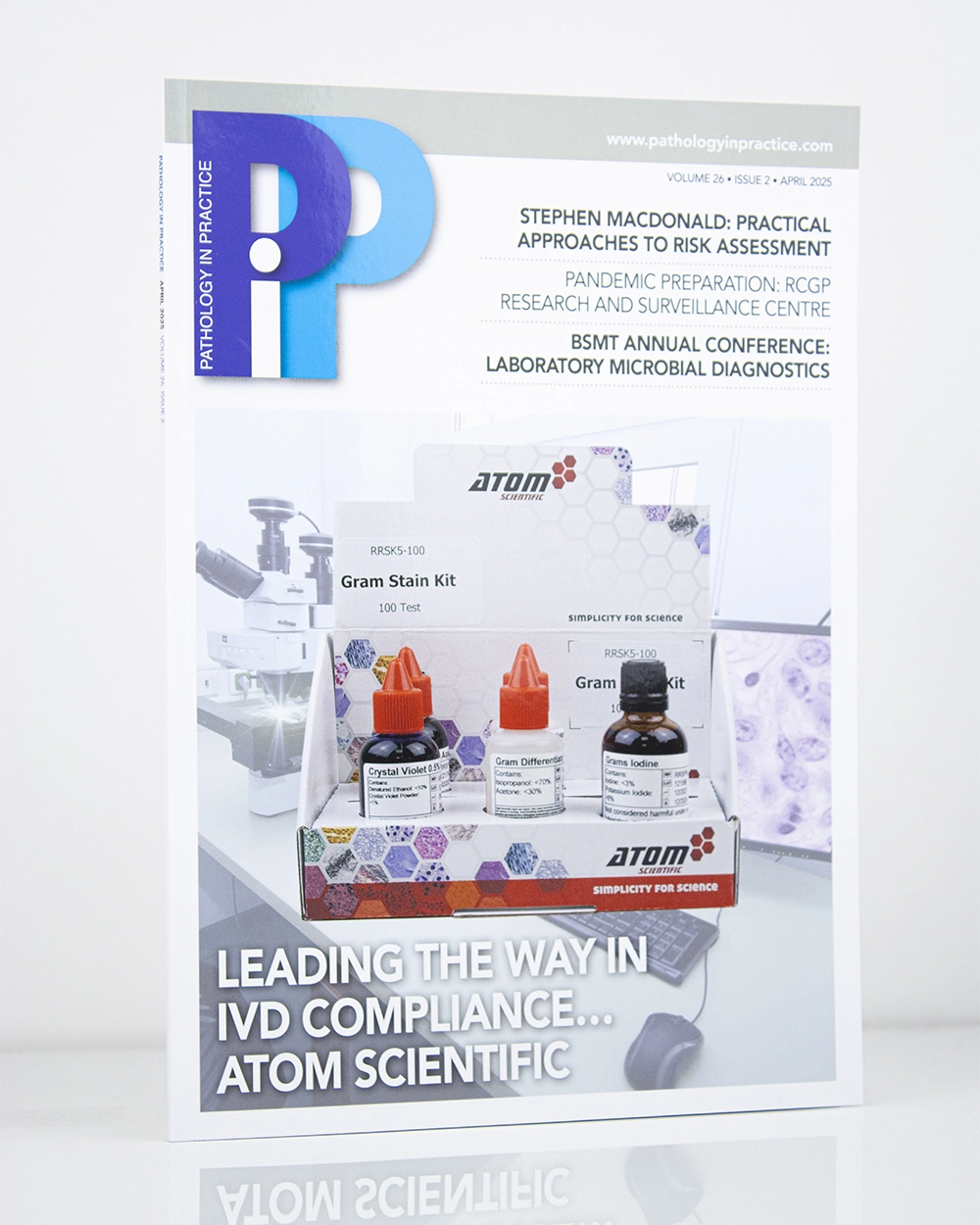We are featured on the Front Cover of Pathology In Practice
"Leading the way in IVD Compliance... Atom Scientific"

We are featured on the front cover in the April edition of Pathology in Practice as we cover the advantages of ready-to-use stain kits in the laboratory. Check out the article featured below.
The advantages of ready-to-use stain kits in the laboratory
Ready-made staining kits have the potential to save time, paperwork and reduce QA challenges in the pathology laboratory. Here, Atom Scientific makes the case for switching to these kits, along with the view from the laboratory.
One of the primary roles of the biomedical scientist in a pathology laboratory is preparing patient samples for analysis. The requirement is for them to be able to prepare samples both quickly and efficiently, while maintaining consistent quality and accuracy. And this is often under the pressures of time, budget and having enough skilled staff to handle the workload of a busy laboratory.
So, how does having access to preformulated and validated stains and stain kits make a difference?
Stains – One of The Three Pillars
If the first two pillars of histopathology include the processing and sectioning of a tissue specimen, the third pillar is the staining process: one of the essential elements before presenting the sample to a pathologist for reporting.
Therefore, biomedical scientists need the stains they use to work first time, work efficiently and be consistently reliable and of high quality. While tradition sometimes dictates that staff formulate their own stains in the laboratory, this can bring its own share of problems: along with tying up busy staff with a manual process, to be compliant with ISO15189 the results must be validated in house for every component prior to use.
In addition, always having the right chemicals to hand means sourcing, validating and storing the raw materials, plus awareness of expiry dates to meet tightening regulations, including UKAS accreditation of ISO standards.
The idea that formulating stains from scratch in the laboratory is a cost-effective method is, more often, a false economy. The better option is using pre-formulated stain kits.
Atom Scientific has compared the cost of its stain kits to that of purchasing the individual components required to make each kit. It’s also important to note that the shelf life of the stain kits and separate raw materials are the same – and each subject to ISO15189 shelf-life requirements.
Though this information does not include the cost of sourcing, purchasing, storing, making or validating each component used in each stain kit, the company believes it demonstrates clearly the benefits of switching to pre-validated stain kits, and that costs can be recouped in a very short period of time.
Ensuring Quality
Employing ready-to-use and validated stain kits in the laboratory saves the modern biomedical scientist time and provides consistent and reliable results within proven protocols.
Atom Scientific’s stain kits, independently assessed and scored by UK NEQAS CPT, and tested in the company’s QC laboratory before supply, gives the external, pre-validated quality
assurance that any pathology laboratory can rely on.
The range of kits on offer all provide complete traceability of all batches and raw materials, so laboratories can be sure there is a robust audit trail if needed. Atom also offers full technical support to ensure users in the laboratory get the best out of the kits.
Some of Atom Scientific’s stain kits contain 20-plus separate raw materials in one, which removes the requirement for laboratories to source – and store – the multiple raw materials used in some stains.
The years of investment the company has made in developing stain kits has resulted in Atom Scientific achieving several quality standards. It is the only UK manufacturer of diagnostic stain kits to comply with the recent EU regulation 2017/746 covering In Vitro Diagnostic Medical Devices for diagnostic use (IVDR) as well as research. This sits alongside the IVDD registration that Atom Scientific obtained several years ago.
Atom’s stain kits and biological stains, while retaining their CE mark outside of the UK, have also this year attained the new UKCA mark for general In Vitro Diagnostic (IVD) devices, which complies with various ISO standards and replaces the former CE mark for the UK markets, since the UK exited the EU.
Reaching these standards for stain quality means Atom Scientific can play a part in its laboratory customers’ own compliance with quality management systems, such as ISO15189 for quality and competence in medical laboratories.
In the Laboratory

Craig Mullarkey is a trainee biomedical scientist working for Leeds Teaching Hospitals NHS Trust at St. James’ University Hospital in Leeds. He explains how Atom Scientific’s ready-made stain kits have been introduced in his laboratory recently.
“In our laboratory, we have an array of stains which we use. When sectioning tissue for slides the standard is obviously the haematoxylin and eosin (H&E) stain, then we have requests for more specialist stains.
“For the stains which we do by hand, we’ve been trying to simplify that process in the laboratory, because in the past we’ve been making up a lot of the stains ourselves using powders and stock solutions, so that’s where the readymade stain kits have come in.
“Some of the stains we found ourselves making up on an almost weekly basis where we have a high throughput of slides – like a van Gieson stain. And for certain tissue types we do sets of stains; liver tissue for example, we do a panel of six different stains, of which two are hand stains. As well as the kits that Atom Scientific do, they also have individual bottles of reagents and in the laboratory, we’re trying to balance the two and always find what works best for us.
“If we can reduce our time mixing stains and buying ready-made reagents from Atom directly, then obviously it saves us time. When we’re mixing our own stains, each batch has to be documented: numbered and dated. It also helps when we’re also assessed for quality, obviously the laboratory is subject to external quality assessment – we have a scheme with UK NEQAS and we’re also assessed by UKAS too.
“Some of the work I’ve been doing has been in validating the processes when we switch to ready-made stain kits. That’s meant staining two sets of slides side by side, using the old and the new method, and those slides are then assessed by a pathologist for comparison and they decide whether it’s worse, the same or better. We then need five sets signed off to be able to switch to the new method.
“Overall, in the laboratory we’ve changed 12 specific stains over the last six months or so. Previously, for each stain that needed mixing, the process would take up to half an hour or so for the more complex ones. While the time aspect isn’t something we’ve been able to track, it has certainly saved time in the laboratory. As well as the time mixing using the ready-made kits has also cut down on the paperwork and there’s a lot less to worry about with the EQA too. So far the kits we’ve been using have been substantially beneficial.
“We’ve had no problems with quality so far, the validation process for each new stain has gone very smoothly. If there were any issues we’d hear about it pretty quickly but so far any comments we’ve received from the pathologists have been very positive.”





